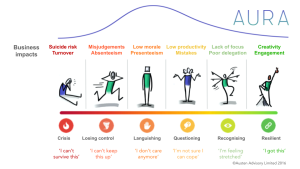With Resilience Specialist Rachel Austen, CPsychol. MBPsS
Leathwaite recently hosted an HR Leaders Roundtable with Organisational Psychologist, Rachel Austen, to discuss trends in resilience and burnout from some of the world’s leading companies. Below we have shared some of the key discussion points from the event.
Rachel shared the latest data from AURA – her proprietary resilience measurement tool – which shows employee resilience has dropped 10% in the past 6 months. The curved purple line represents the benchmark. The average employee is currently in the ‘Languishing’ zone – feeling empty, stagnant and with a low sense of purpose.

Several leaders shared experiences of working in high-performing organisations with an “up or out” culture in which individuals who got to critical stages of burnout would simply leave, leaving an organisation whose employees were all in a “resilient” state.
We discussed how the price of being an organisation that “burns through” employees in this way is the lack of diversity amongst those who remain.
Rachel has been able to use the AURA tool to provide detailed resilience analysis, enabling organisations to pinpoint and address the root causes of stress.



